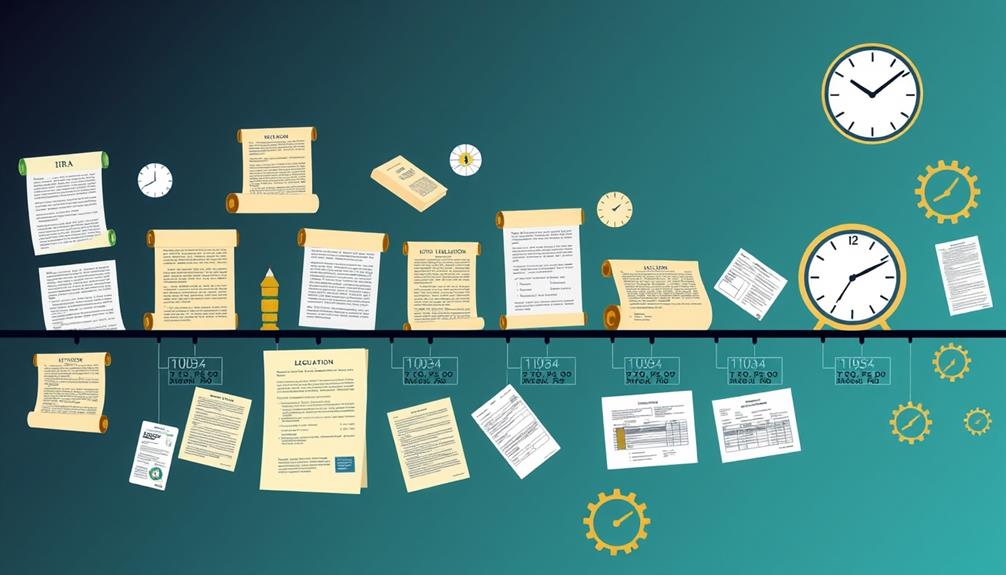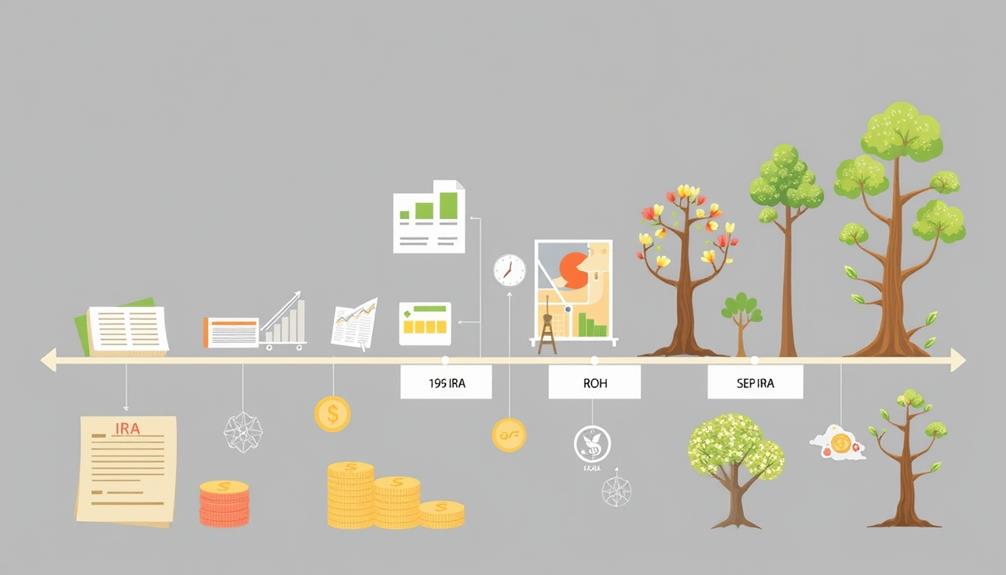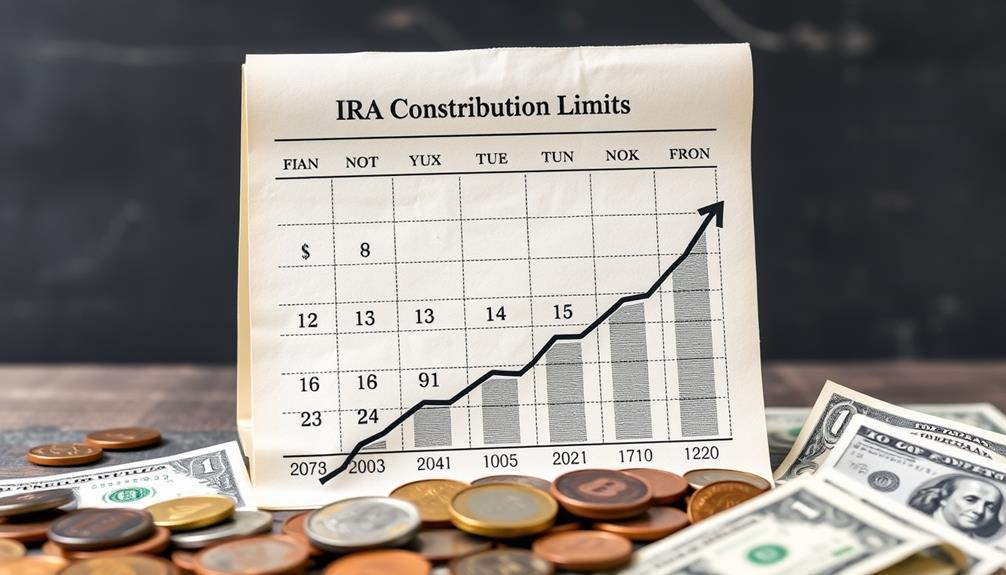You’ve witnessed the transformation of **retirement accounts**, particularly IRAs, throughout history. The inception of **traditional IRAs** in 1974 granted individuals enhanced control over their savings. The introduction of 401(k) plans in 1978 shifted the retirement burden to workers. The arrival of **Roth IRAs** in 1997 brought about tax-free withdrawals and increased flexibility. Ongoing legislative modifications have impacted contribution limits and regulations regarding **Required Minimum Distributions**. Now, you have the authority to make educated investment decisions to safeguard your financial well-being. There are countless more details to uncover regarding these changes and how they affect your retirement, so keep exploring to stay ahead.
Key Takeaways
- The 1974 ERISA legislation established Individual Retirement Accounts (IRAs) to promote personal savings for retirement.
- Roth IRAs were introduced in 1997, allowing after-tax contributions and tax-free withdrawals after age 59½.
- Contribution limits for IRAs have increased over the years, reaching $7,000 for 2024, with additional catch-up contributions for those aged 50+.
- The SECURE Act and SECURE 2.0 Act introduced reforms to improve access and benefits for retirement accounts, including automatic enrollment in 401(k) plans.
- Roth IRAs are exempt from required minimum distributions (RMDs) during the account holder's lifetime, offering greater flexibility in retirement planning.
Historical Development of Retirement Accounts

The evolution of retirement accounts reflects a growing awareness of the importance of financial security in later life. It all began in 1875 when American Express established the first U.S. pension plan, offering a glimpse into formal retirement savings. However, many Americans still lacked any retirement plans for decades.
The Social Security Act of 1935 marked a significant advancement, providing guaranteed income for retirees, but many needed additional retirement savings to thrive. As financial markets became more volatile, the need for diversification in retirement portfolios grew, leading to options like IRA rollovers to gold that protect against inflation and market downturns.
Fast forward to 1974, when the Employee Retirement Income Security Act (ERISA) introduced Individual Retirement Accounts (IRAs), aiming to enhance personal retirement savings amid rising concerns about pension security.
Then came the Revenue Act of 1978, which established the 401(k) plan as a defined contribution option. This major shift placed the responsibility for retirement savings more directly on you, the employee.
In 1997, Roth IRAs entered the scene, allowing for tax-free withdrawals in retirement, further diversifying your retirement savings tools.
Together, these developments have transformed how you prepare for retirement, making it essential to explore the various options available to you today.
The Rise of the 401(k)

In 1978, a revolution in retirement savings began with the introduction of the 401(k) plan under the Revenue Act. This marked a significant shift in retirement accounts, moving from traditional employer-funded pension plans to employee-controlled accounts. The flexibility offered by 401(k) plans allows individuals to actively manage their retirement savings, reflecting the growing trend of personal accountability in financial planning.
By 1982, nearly half of large employers adopted 401(k) plans, dramatically increasing employee participation in retirement savings.
As participation in pension plans plummeted from nearly 50 million in 1980 to about 11.6 million in 2022, defined contribution plans, particularly 401(k)s, surged from under 19 million participants to nearly 88 million. This change allowed employees greater flexibility in choosing their investment options, placing much of the responsibility for retirement savings squarely on individuals. Understanding common financial terms further empowers workers to make informed decisions regarding their investments.
IRS regulations established in 1981 confirmed the legal deferral of payroll compensation to 401(k) accounts, solidifying their importance in the U.S. retirement landscape.
With these employee-controlled accounts, workers now have the power to shape their financial futures, making informed choices about their retirement savings. The rise of the 401(k) has fundamentally transformed how Americans plan for retirement, enabling a more personalized approach to building wealth for later years.
Evolution of Roth Accounts

Since their introduction in 1997, Roth accounts have transformed the landscape of retirement savings by offering a unique tax advantage: individuals can make after-tax contributions and enjoy tax-free withdrawals in retirement, provided certain conditions are met. Initially, contributions to Roth IRAs were limited to $2,000 annually, but that limit has increased to $7,000 for the 2024 tax year, with an additional $1,000 catch-up contribution for those aged 50 or older.
Roth IRAs stand out because they're exempt from required minimum distributions (RMDs) during the account holder's lifetime, allowing funds to grow tax-free for longer periods. As of 2023, approximately 31.9 million U.S. households own a Roth IRA, underscoring its popularity.
The SECURE Act 2.0, enacted in 2022, further enhanced Roth accounts by enabling employer contributions and eliminating RMDs for Roth 401(k) accounts. This evolution reflects a shift towards greater flexibility and tax efficiency in retirement savings.
| Feature | Roth IRA | Traditional IRA |
|---|---|---|
| Contribution Limit | $7,000 ($8,000 if 50+) | $6,500 ($7,500 if 50+) |
| Tax Treatment | After-tax contributions | Pre-tax contributions |
| RMDs during Account Holder's Lifetime | None | Required Minimum Distributions |
Understanding Required Minimum Distributions

When you reach age 73, it's time to start understanding Required Minimum Distributions (RMDs) for your traditional IRA or 401(k).
These distributions can greatly impact your retirement planning, especially if you consider diversifying your investments with options such as a Gold IRA to hedge against market volatility a range of precious metal investment options.
You'll need to calculate how much you should withdraw each year based on your account balance and life expectancy.
Keep in mind that these distributions can affect your tax situation, so knowing the rules is essential.
RMD Basics Explained
Understanding Required Minimum Distributions (RMDs) is vital for managing your retirement savings effectively. Starting at age 73, you must take RMDs from traditional IRAs and 401(k) accounts. The amount you need to withdraw is calculated based on your account balance and the IRS life expectancy tables, which vary for each individual.
Here's a quick overview of how RMDs work:
| RMD Feature | Traditional IRAs/401(k)s | Roth IRAs |
|---|---|---|
| Age to Start RMDs | 73 | None during account holder's lifetime |
| Tax Implications | Taxable income | No RMDs, tax-free growth |
| Penalty for Non-compliance | 50% penalty on missed RMD | N/A |
Failing to withdraw your RMD can lead to a hefty penalty of 50% on the amount not withdrawn, affecting your overall tax liabilities. Since the amount you take out is considered taxable income in the year it's received, proper retirement planning is significant. Keep in mind, Roth IRAs provide a unique advantage, as they're exempt from RMDs during your lifetime, allowing for more tax-efficient growth.
Calculating RMD Amounts
Calculating your Required Minimum Distribution (RMD) is vital to guarantee compliance and effective retirement planning. If you have traditional IRAs or 401(k) accounts, starting at age 73, you'll need to make mandatory withdrawals.
To determine your RMD, divide your account balance as of December 31 of the previous year by a life expectancy factor from the IRS's Uniform Lifetime Table. This calculation guarantees you withdraw the correct amount, helping you avoid the severe penalty of 50% on any shortfall.
Keep in mind that RMDs are taxed as ordinary income, which can impact your tax liabilities. Withdrawing more than the minimum can affect your overall tax situation, potentially pushing you into a higher tax bracket.
However, if you hold a Roth IRA, you're in luck—these accounts are exempt from RMDs during your lifetime, allowing for tax-free growth without mandatory withdrawals.
Understanding how RMDs work is vital for managing your retirement accounts effectively. By calculating your RMD accurately, you can maintain compliance while optimizing your retirement strategy.
Tax Implications of RMDs
Required Minimum Distributions (RMDs) can greatly affect your tax situation in retirement. When you reach age 73, you must start withdrawing from your traditional IRAs and 401(k) accounts. The amount you withdraw is determined by your account balance and life expectancy, according to IRS tables. These withdrawals are typically subject to ordinary income tax, which can considerably impact your overall tax liability.
If you fail to withdraw the required amount, you could face a hefty penalty of 50% on the amount you should've taken out. This makes understanding RMDs essential for effective retirement planning. Conversely, Roth IRAs are not subject to RMDs during your lifetime, providing a strategic advantage to reduce tax implications.
Here's a quick summary of RMDs and their tax implications:
| Aspect | Traditional IRAs |
|---|---|
| RMD Start Age | 73 |
| Subject to Ordinary Tax | Yes |
| Penalty for Noncompliance | 50% of the required amount |
| RMDs Required | Yes |
As you navigate retirement, consider how RMDs will shape your tax strategy.
Legislative Changes Impacting IRAs

As retirement planning evolves, legislative changes have played a crucial role in shaping Individual Retirement Accounts (IRAs) and enhancing their benefits. The Taxpayer Relief Act of 1997 introduced Roth IRAs, allowing you to enjoy tax-free withdrawals after age 59½, which greatly broadened your retirement savings options.
Additionally, the rise of alternative investments, such as precious metals, has become increasingly relevant, providing opportunities for diversification in retirement portfolios, especially through options like Gold IRA Rollovers.
More recently, the SECURE Act of 2019 made strides in improving retirement security by allowing part-time workers to participate in retirement plans and incentivizing small businesses to offer IRAs.
The SECURE 2.0 Act of 2022 took things further by introducing automatic enrollment in 401(k) plans and eliminating required minimum distributions (RMDs) for Roth IRAs, giving you more flexibility in your retirement planning.
Contribution limits have also evolved, with the limit set to rise to $7,000 for 2024, reflecting inflation adjustments aimed at encouraging retirement savings.
Additionally, legislative measures have allowed for catch-up contributions for those aged 50 and older, further supporting your efforts to build a robust retirement fund.
These ongoing changes continue to shape the IRA landscape, ensuring you have the tools needed for a secure financial future.
The Role of Financial Advisors

When it comes to planning for your retirement, financial advisors are essential partners.
They help you navigate the complexities of IRAs and create tailored investment strategies that fit your goals. Additionally, they can provide insights on how to avoid Gold IRA scams and guarantee you're making informed decisions.
Plus, they keep you informed about regulatory changes that could impact your savings plan.
Importance of Financial Planning
Maneuvering the complexities of retirement accounts like IRAs can feel overwhelming, but that's where financial advisors come in. They help you understand intricate details, such as contribution limits and tax implications, which the IRS periodically adjusts. With nearly 42.2% of U.S. households owning an IRA, professional guidance is essential for managing these substantial assets.
Advisors work with you to create personalized financial plans that align with your individual goals and risk tolerance. This approach optimizes your long-term savings and investment strategies. Furthermore, with ongoing legislative changes like the SECURE Act and SECURE 2.0, staying informed about new rules and opportunities is crucial for enhancing your retirement security.
Here's a quick comparison of how financial advisors can impact your financial planning:
| Role of Financial Advisors | Benefits | Key Areas of Focus |
|---|---|---|
| Guiding IRAs | Clarity on contribution limits | Tax implications |
| Personalized planning | Tailored strategies | Wealth management |
| Legislative updates | Staying informed | SECURE Act impacts |
| Long-term savings | Enhanced retirement security | Risk management |
In today's landscape of declining traditional pensions and increased life expectancy, the expertise of financial advisors is more important than ever for sustainable wealth management.
Tailored Investment Strategies
Financial advisors are essential in crafting tailored investment strategies for your Individual Retirement Accounts (IRAs). They help you navigate the complexities of IRA contribution limits and tax implications, guaranteeing you make informed decisions that align with your financial goals.
With their expertise, you can optimize asset allocation within your accounts based on your risk tolerance and retirement income needs. For those considering diversifying their portfolios, Gold IRAs offer potential benefits as a hedge against inflation and economic downturns.
When deciding between traditional IRAs and Roth IRAs, a financial advisor can guide you by considering your current income and expected future tax rates. This personalized financial advice is vital for maximizing growth potential while minimizing tax liabilities.
Additionally, they keep you informed about legislative changes, such as those introduced by the SECURE Act, which can impact your retirement planning strategies.
With approximately 42.2% of U.S. households owning an IRA, the importance of tailored investment strategies can't be overstated. By working with a financial advisor, you can guarantee that your investment strategies are well-suited to your unique situation, ultimately helping you build a secure financial future.
Don't underestimate the value of having expert guidance on your retirement journey.
Navigating Regulatory Changes
Understanding regulatory changes is essential for anyone managing an Individual Retirement Account (IRA). Financial advisors help you navigate these complexities, particularly with the updated contribution limits, which are set at $7,000 for IRAs in 2024.
They also guide you through the implications of legislative reforms like the SECURE Act and SECURE 2.0, which have expanded access to retirement plans and altered rules on employee enrollment and late contributions. Additionally, as investors explore options like gold IRAs for diversification, advisors can provide insights on the Gold Investment Strategies that align with retirement goals.
If you're considering a Roth IRA, your advisor can explain the differences in tax treatment, highlighting the benefits of tax-free withdrawals in retirement. With the IRS guidelines governing IRAs—including rollover processes and penalties for excess contributions—compliance can be challenging without professional help.
As more U.S. households, now at 42.2%, invest in IRAs, financial advisors become increasingly important. They provide tailored financial planning strategies that adapt to your unique circumstances and retirement goals.
Future Trends in Retirement Savings

As individuals navigate the evolving landscape of retirement savings, future trends are set to reshape how you approach your financial planning. Emphasizing personalized financial advice will allow you to tailor strategies to your unique circumstances.
Legislative changes like the SECURE Act 2.0 will enhance retirement savings opportunities by mandating employee enrollment in 401(k) plans and increasing contribution limits for older Americans. Additionally, the growing demand for AI ethicist jobs may lead to innovative tools that provide tailored financial guidance based on ethical considerations.
You might also notice a significant rise in the popularity of Roth IRAs. With their tax-free withdrawal benefits and the elimination of required minimum distributions, they're becoming a go-to option for retirement planning.
Additionally, advancements in technology will provide better access to investment resources, empowering you to manage your retirement savings more effectively.
Here are a few key trends to watch:
- Increased focus on personalized financial advice to meet individual needs.
- Legislative reforms that boost contribution limits and simplify retirement savings.
- A rise in financial literacy initiatives, helping you maximize your retirement savings.
Frequently Asked Questions
How Does an IRA Grow Over Time?
An IRA grows over time through compound interest, where your earnings reinvest to generate more earnings. Tax-deferred growth in traditional IRAs and tax-free benefits in Roth IRAs enhance your overall retirement savings potential.
What Is the History of Iras?
Think of IRAs like a garden; you plant seeds in 1981, and they flourish over time. By 2023, nearly 42.2% of households nurture these accounts, growing $13 trillion in retirement assets. It's a crucial journey!
What Changes Are Coming to IRA Accounts?
Starting in 2024, you'll see higher IRA contribution limits, automatic enrollment provisions, and Roth IRAs exempt from required minimum distributions. These changes aim to boost retirement savings and accessibility for many individuals.
What Happens to Old IRA Accounts?
Old IRA accounts can be like treasure chests waiting to be opened! They keep growing until you're 73, but if inactive too long, they might vanish into state hands. Stay proactive and manage them wisely!
Conclusion
So, as you contemplate your retirement savings, remember: you're not just investing for the future; you're participating in a grand game of financial Twister! With each legislative twist and turn, and the ever-evolving landscape of IRAs, you might just find yourself tangled up in jargon. But hey, at least you'll have a colorful portfolio to show for it! Embrace the chaos, and laugh all the way to the bank—just don't forget to consult your financial advisor first!
Helen brings a wealth of experience in investment strategy and a deep passion for helping individuals achieve their retirement goals. With a keen understanding of market dynamics, Helen has been instrumental in shaping the vision and direction of Gold IRA Markets. She specializes in creating innovative solutions that align with our clients’ long-term investment objectives.










